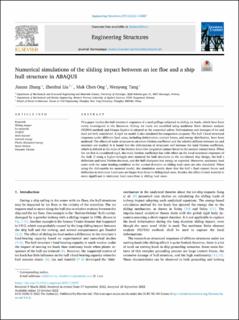| dc.contributor.author | Zhang, Jianan | |
| dc.contributor.author | Liu, Zhenhui | |
| dc.contributor.author | Ong, Muk Chen | |
| dc.contributor.author | Tang, Wenyong | |
| dc.date.accessioned | 2023-02-09T14:48:45Z | |
| dc.date.available | 2023-02-09T14:48:45Z | |
| dc.date.created | 2022-10-14T17:27:29Z | |
| dc.date.issued | 2022 | |
| dc.identifier.citation | Zhang, J., Liu, Z., Ong, M. C., & Tang, W. (2022). Numerical simulations of the sliding impact between an ice floe and a ship hull structure in ABAQUS. Engineering Structures, 273, 115057. | en_US |
| dc.identifier.issn | 0141-0296 | |
| dc.identifier.uri | https://hdl.handle.net/11250/3049834 | |
| dc.description.abstract | This paper studies the hull structural responses of a steel grillage subjected to sliding ice loads, which have been rarely investigated in the literature. Sliding ice loads are modelled using nonlinear finite element analysis (NLFEA) method; and Abaqus Explicit is adopted as the numerical solver. Deformations and damages of ice and steel are both considered. A rigid ice model is also simulated for comparison purposes. The hull’s local structural responses under different load cases, including deformation, contact forces, and energy distribution, have been analysed. The effects of static structure-to-structure friction coefficient and the relative stiffness between ice and structure are studied. It is found that the deformation of structures will increase the total friction coefficient, which is defined as the ratio of the friction force (the tangential contact force) to the normal contact force. When the ice floe is considered rigid, the static friction coefficient has little effect on the local structural responses of the hull. If using a higher-strength steel material for hull structures in the ice-classed ship design, the hull’s deflection and total friction decrease, and the hull dissipates less energy as expected. Moreover, stationary load cases with the same loading condition in the normal direction as sliding load cases are also simulated. When using the deformable ice material model, the simulation results show that the hull’s final contact forces and deflection in stationary load cases are larger than those in sliding load cases. Besides, the effect of steel material is more significant in stationary load cases than in sliding load cases. | en_US |
| dc.language.iso | eng | en_US |
| dc.publisher | Elsevier | en_US |
| dc.rights | Navngivelse 4.0 Internasjonal | * |
| dc.rights.uri | http://creativecommons.org/licenses/by/4.0/deed.no | * |
| dc.title | Numerical simulations of the sliding impact between an ice floe and a ship hull structure in ABAQUS | en_US |
| dc.title.alternative | Numerical simulations of the sliding impact between an ice floe and a ship hull structure in ABAQUS | en_US |
| dc.type | Peer reviewed | en_US |
| dc.type | Journal article | en_US |
| dc.description.version | publishedVersion | en_US |
| dc.rights.holder | The authors | en_US |
| dc.subject.nsi | VDP::Teknologi: 500 | en_US |
| dc.source.volume | 273 | en_US |
| dc.source.journal | Engineering structures | en_US |
| dc.source.issue | 115057 | en_US |
| dc.identifier.doi | 10.1016/j.engstruct.2022.115057 | |
| dc.identifier.cristin | 2061562 | |
| cristin.ispublished | true | |
| cristin.fulltext | original | |
| cristin.qualitycode | 2 | |

